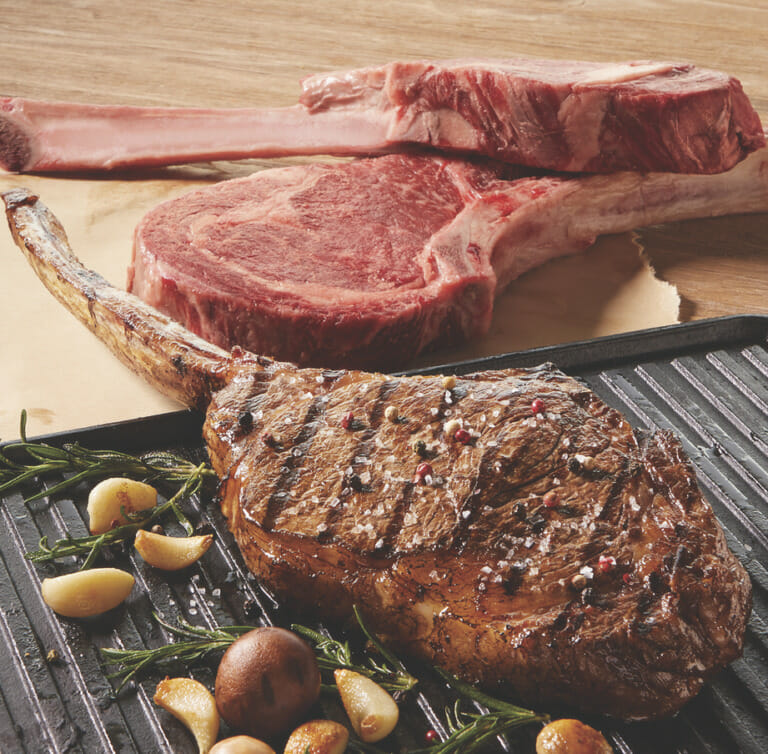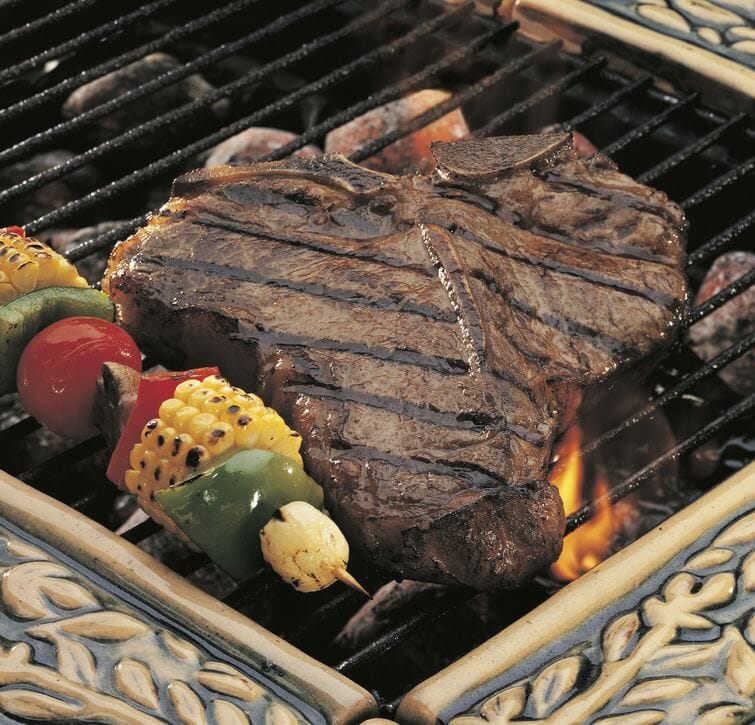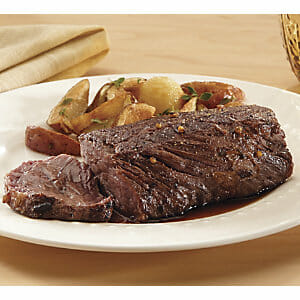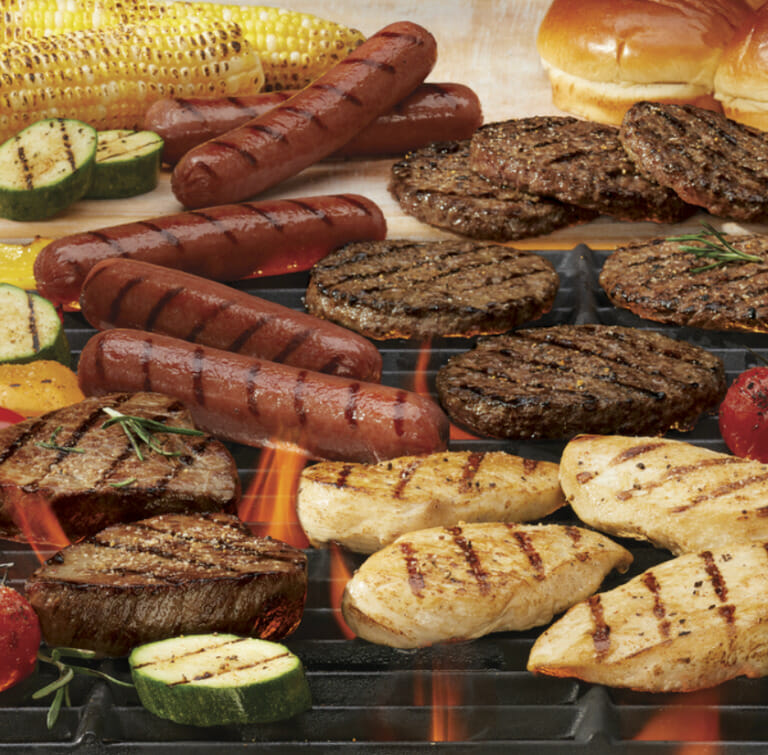How to Reverse Sear a Steak
Reverse-seared steak is all the rage these days…but what is it? Learn how to reverse sear rib eye and other thick cuts for the best steak of your life.
You sit down to a beautiful thick-cut rib eye steak. It was carefully grilled with a perfect sear on the outside; you even used an instant-read thermometer to ensure it would be exactly medium-rare in the center. And when you cut into it, you find that the center is indeed a deep, rosy pink…or, at least, the middle half-inch or so. But there’s a transitional layer on either side of the center where the meat has turned to—gasp—a dull gray. To your horror, a good-sized portion of your precious steak is medium-well to well done! What happened?

The simple answer is that your steak was too thick to cook by the usual method. It’s true that a tender cut like rib eye, New York strip or filet mignon is best cooked quickly over high, direct heat…and if your steak is an inch thick or less, that’s still your best bet. But if you’re grilling a thicker cut (say, one and a half or two inches), cooking it for the same length of time will leave the middle very rare. If you want the center medium-rare, it’s going to have to stay on the grill or in the skillet for a longer period of time…and the sections of meat closer to the surfaces are going to cook beyond what you may find acceptable. It’s simple physics. So what’s the solution?
Well, you could just stop buying thick-cut steaks…but that’s no fun. Instead, consider changing your cooking method and learn to master the reverse-sear steak.
How Do I Reverse-Sear a Steak?
In a word, slowly. (Before we get any further, let’s note upfront that this is not something you’re going to do on a weeknight when you’re pressed for time.)
The concept here is simple: The smaller the cut of meat, the hotter and faster you can cook it. Get that sear on it quickly, then take it off the heat before it has time to overcook. Conversely, the larger the cut of meat, the lower and slower you want to cook it. Let’s take a bone-in prime rib roast, for instance. You want that nice brown, flavorful sear on the outside, so you start it in a hot oven…but you don’t want it to overcook or be raw in the middle, so after the initial hot roast, you turn the oven down and let it roast slowly until it’s just right in the center. Reverse-searing is, well, the reverse of that. You slowly cook the steak until it’s the right temperature in the center—or close to it—then quickly sear the outside. Alton Brown, of Food Network’s “Good Eats” show, uses the reverse method for roasts, too: slow-roast at 200 degrees until the roast is 10 degrees below the target temperature, then remove it from the oven, crank the oven up to 500 degrees, put the meat back in and let the crust develop.
The steak reverse sear began in professional kitchens outfitted with sous vide equipment. Sous vide (pronounced soo-VEED), which translates to “under vacuum” in French, involves vacuum sealing food in a plastic bag, then cooking it to a precise temperature in a water bath. It is impossible to overcook food in this method, since the water bath is held at the exact temperature at which you want your food. Using sous vide, a chef could bring a number of steaks to rare, hold them for an indefinite period of time, then sear them to order for any customer. This technique has been around since the 1970s, but the equipment was so expensive that it was virtually unavailable to the home cook. Sous vide is now much more affordable, but it’s still not inexpensive…and many people don’t care for cooking their food in plastic bags which then wind up in landfills. So some inventive food professionals came up with a steak reverse sear method using standard cooking equipment: the indoor kitchen range and the outdoor grill.
Reverse-Seared Steak in the Kitchen
To reverse sear a steak on your kitchen range—you’ll actually be using your oven, too—you’ll need a baking sheet with a wire rack, a cast-iron skillet, tongs, an instant-read meat thermometer, and about an hour of cooking time. Let’s break it down step by step:
1. Season. Salt and pepper will do, and a good steak seasoning is even better, provided it has enough salt to act as a “dry brine”: The salt draws moisture out of the meat, the moisture dissolves the salt, and the steak then reabsorbs the juices. Season the steak liberally, then put it on the wire rack over the baking sheet and stick it in the fridge. If you can do this a couple of hours or even overnight before cooking, perfect. A dry surface browns much better.
2. Preheat oven. Set it anywhere from 200 to 275 degrees. The lower the heat, the more evenly cooked the steak will be. 275 will be faster, of course, but you’ll want to watch the temperature closely.
3. Slow-roast. Depending on the size and thickness of your steaks, this should take 45 minutes to an hour…maybe longer if the oven is at 200 degrees. Check the temperature frequently with an instant-read thermometer, and pull the steaks when the temperature is 10 or 15 degrees lower than your target temperature. For medium-rare, you want an internal temp of 135 degrees*, so pull your steak at 120 or 125 degrees. Tent it with foil and let the steak rest 10 to 15 minutes while you preheat your cast-iron skillet.
4. Pan-sear. Set your burner on high and preheat your skillet until it is smoking hot. (Now is a great time to turn your exhaust fan on, too.) Add your steak to the skillet and sear for 45 seconds to a minute. Turn the steak, and repeat for the other side. If you want, hold the steaks sideways for a moment to sear the edges.
5. Serve immediately. Unlike with other methods, there is no need to let your steaks rest before serving; you already did that before you seared them.

Reverse-Seared Steak on the Grill
A reverse-seared steak on the grill is even easier, if a little less precise than using your oven, and you won’t have that cast-iron skillet to clean up. Here are the steps:
1. Season. As above.
2. Preheat grill. Set it up for indirect heat. If you’re using gas, light one side and set it on high; leave the other side unlit. If the temperature gets too high, turn it down. For a charcoal grill, either have all the coals pushed to one side or use racks to keep the coals on two sides and leave the center open. Add charcoal as needed to maintain temperature.
3. Slow-roast. Do this as above, remembering that a grill is not as precise as an oven and you’ll need to check the internal temperature of the meat more frequently. Again, pull the steak when the temperature is 10 or 15 degrees lower than your target. Tent it with foil and let it rest while you turn all burners on high so the grill gets as hot as it can. (If using charcoal, just make sure both sides are well stoked with red-hot coals, not open flame.)
4. Sear. Put your steak directly over the coals or hot burner and sear for 45 seconds to a minute. Turn the steak, and do the other side.
5. Serve. You’re ready to enjoy a perfectly grilled steak.
Remember, reverse searing isn’t for every steak. If you’re preparing inch-thick (or less) T-bone or New York strip steaks, good old direct heat as we discuss in Grilling 101 is nice and fast and does the perfect job. But if you’re doing a thick, juicy bone-in rib eye or filet mignon, reverse searing will give you the even, wall-to-wall doneness you’re looking for without the dried-out gray layer that can so often happen with these steaks.
Enjoy!
*Note: The United States Department of Agriculture (USDA) recommends that whole cuts of meat be cooked to at least 145 degrees and rested for three minutes.



